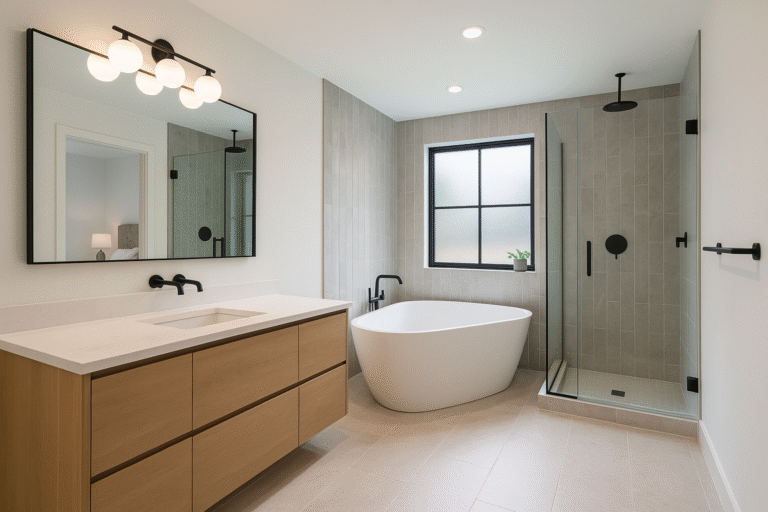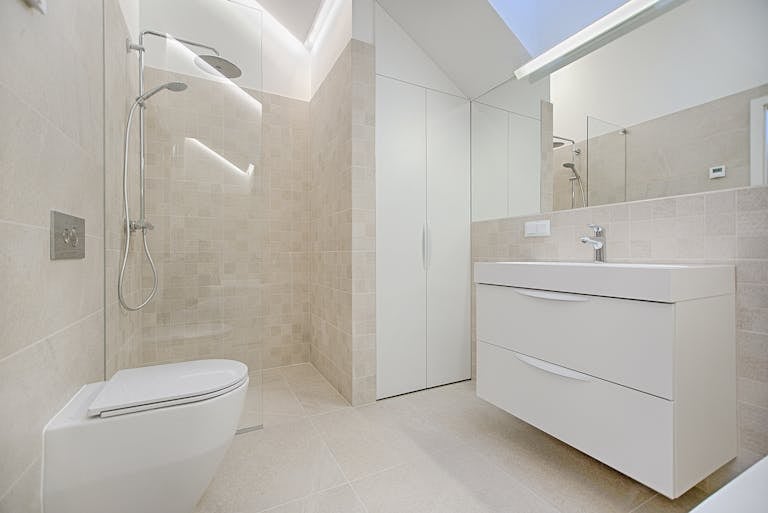How to Choose Exhaust Fans: A CFM Guide for Optimal Ventilation
Exhaust fans play a crucial role in maintaining proper ventilation in your home, especially in areas like bathrooms, kitchens, and laundry rooms where moisture and odors can build up. Without proper ventilation, these areas can become breeding grounds for mold, mildew, and unpleasant smells, leading to more significant problems down the line.
One of the most important factors to consider when choosing an exhaust fan is the CFM rating, or Cubic Feet per Minute. This rating tells you how much air the fan can move in one minute and is critical to ensuring that your fan is powerful enough to do the job. The right CFM ensures effective moisture removal, better air quality, and a more comfortable environment.
In this guide, we’ll help you understand how to select the right exhaust fan based on CFM, taking into account your space size, ventilation needs, and additional features that will enhance fan performance.
Why Choosing the Right Exhaust Fan is Important
Exhaust fans are essential in any home where humidity or strong odors are a concern. Their primary role is to ensure proper airflow, which helps prevent moisture buildup and removes stagnant air. By selecting the right fan, you’ll be able to maintain better air quality, reduce the chances of mold growth, and keep your home smelling fresh.
The Role of Exhaust Fans in Maintaining Air Quality
Exhaust fans work by pulling moist, stale air out of a room and expelling it outside. In places like bathrooms and kitchens, where humidity levels are high due to showers, cooking, or washing, this airflow helps reduce moisture, preventing condensation on surfaces. Without an exhaust fan, moisture can lead to water damage, mold, and mildew, which can negatively impact the air quality in your home.
In kitchens, exhaust fans also help remove cooking odors, grease, and smoke. In bathrooms, they eliminate odors and prevent excess moisture that could otherwise lead to mold growth around shower walls, mirrors, and floors.
Preventing Moisture Buildup and Mold Growth
One of the biggest benefits of a properly sized exhaust fan is its ability to reduce moisture levels in your home. If a bathroom or kitchen doesn’t have adequate ventilation, moisture can accumulate, leading to a range of issues such as mold, mildew, and rot.
Mold thrives in damp environments, especially in rooms with poor ventilation. An exhaust fan that effectively removes excess moisture reduces the likelihood of mold spores taking hold in areas with high humidity. Choosing the right fan is key to maintaining a mold-free and healthy environment in these moisture-prone areas.
Reducing Odors and Promoting Comfort
Exhaust fans also serve to improve the overall comfort of your home by reducing odors. In kitchens, they can remove lingering food smells, while in bathrooms, they eliminate unpleasant odors and provide fresh air after showers or baths. Proper ventilation helps keep your home comfortable and free from unpleasant odors that can make a space feel stuffy or unpleasant.
Understanding CFM: What Is Cubic Feet Per Minute?
Before selecting an exhaust fan, it’s essential to understand what CFM means and why it’s important. CFM (Cubic Feet per Minute) is a measure of the airflow that an exhaust fan provides. It indicates how much air the fan can move in one minute, and the higher the CFM, the more air the fan will circulate.
What Does CFM Measure?
CFM measures the volume of air the exhaust fan can move within a room. For example, a fan with a 100 CFM rating can move 100 cubic feet of air per minute. The more CFM a fan has, the more effective it is at ventilating a space and eliminating moisture, odors, and stale air.
Understanding your room’s CFM requirements is essential to ensuring that your fan is powerful enough to handle the job. If the fan’s CFM is too low, it won’t adequately ventilate the room, leaving moisture and odors to linger. If it’s too high, it could be unnecessarily expensive and create excessive noise.
How CFM Relates to Airflow and Ventilation Efficiency
The efficiency of an exhaust fan is directly tied to its CFM rating. A higher CFM means more airflow, which is especially important for large or high-humidity spaces like bathrooms with showers or kitchens with stoves. The right CFM ensures that air is replaced quickly and moisture is removed before it can cause damage or mold growth.
When selecting a fan, you want to ensure that its CFM matches the size and ventilation needs of the room it’s intended for. A bathroom with a shower, for example, will require a higher CFM than a smaller powder room, because more moisture is generated from showering and bathing.
How to Calculate the Ideal CFM for Your Space
To ensure that your exhaust fan is the right size for your room, you’ll need to calculate the required CFM based on the size of the space and its specific needs. While a general guideline can be used, factors like room dimensions, moisture levels, and the type of space all play a role in determining the optimal fan size.
Step-by-Step Guide for Calculating the Necessary CFM for Different Rooms
Calculating the required CFM for your room is straightforward. The basic formula is as follows:
CFM = Room Length × Room Width × Ceiling Height ÷ 60
This formula gives you the necessary CFM for any room based on its dimensions, ensuring that the fan will properly ventilate the space. For example, if you have a bathroom that is 8 feet long, 6 feet wide, and has an 8-foot ceiling, the calculation would be:
CFM = 8 × 6 × 8 ÷ 60 = 64 CFM
This means you would need an exhaust fan with at least 64 CFM for that room to properly ventilate it. However, this is just the starting point. You may need to adjust the calculation based on other factors, which we’ll discuss next.
The Basic Formula for Bathroom CFM Calculation
In bathrooms, you typically want 1 CFM for every square foot of space. For example, if your bathroom is 100 square feet, you’ll need a fan with at least 100 CFM. However, if your bathroom has a shower or bathtub, you should increase the CFM by 50 for each additional fixture. For example, a bathroom with a shower would need an additional 50 CFM, so a 100-square-foot bathroom with a shower would require a fan with at least 150 CFM.
How to Adjust CFM for Specific Conditions
While the above calculation provides a general guideline, there are a few additional considerations that may require you to adjust the CFM further:
- High Ceilings: If the room has high ceilings (greater than 8 feet), you may need to increase the CFM to account for the extra air volume. A higher ceiling means more air needs to be moved to maintain proper ventilation.
- Moisture Levels: If your room experiences a high level of moisture (like a bathroom with multiple water fixtures or a kitchen with heavy cooking steam), you’ll want to increase the CFM to ensure effective moisture removal.
- Room Type: A small powder room requires far less CFM than a large master bathroom with a shower. Similarly, kitchens and laundry rooms, which generate more moisture, will require more CFM than a typical bathroom.
Exhaust Fan Sizing: CFM Requirements for Different Rooms
Once you understand how to calculate CFM, it’s important to match the CFM rating of the fan with the needs of each room. Different spaces require different ventilation capacities based on their size, moisture levels, and function.
Ideal CFM for Bathrooms (Small vs. Large)
- Small Bathrooms: For a small bathroom (around 50 square feet), you typically need at least 50-75 CFM, depending on the number of fixtures. If the bathroom has a shower or bathtub, you should increase the CFM accordingly. As a rule of thumb, use 1 CFM per square foot for a small bathroom.
- Large Bathrooms: For larger bathrooms (over 100 square feet), you’ll need a fan with a higher CFM. The CFM should be 1.5 to 2 times the square footage, depending on whether the room has multiple moisture-generating fixtures (like a shower, tub, and double sinks). For instance, a 120-square-foot bathroom with a shower will need a fan rated at 180 CFM.
Kitchen Exhaust Fan CFM Requirements
Kitchens require a higher CFM rating due to cooking steam, grease, and odors. For kitchens, a fan should move at least 100 CFM for every 12-15 square feet of space. A kitchen with a stove and range hood may require an additional 50-100 CFM to handle the extra moisture and smoke generated during cooking.
- Standard Kitchen: For a typical kitchen of 200 square feet, the required fan CFM would be around 200 CFM. However, this may need to be adjusted depending on the size of your kitchen, the number of cooking appliances, and whether the kitchen is open or closed.
- Range Hoods: If you’re installing an exhaust fan above a stove or range, choose a fan with at least 100 CFM per 12 inches of stove width. For example, a 36-inch wide stove would need an exhaust fan rated at 300 CFM.
Laundry Room Exhaust Fan Sizing
Laundry rooms also need proper ventilation to prevent moisture buildup, especially when running the dryer. Typically, the recommended CFM for laundry rooms is about 1 CFM per square foot of space. For example, a 150-square-foot laundry room would need at least a 150 CFM exhaust fan. You may need a stronger fan if the room has high humidity, especially when the dryer is in use.
How to Select the Right Exhaust Fan Based on Room Type
Choosing the right exhaust fan depends on the type of room and its specific ventilation needs. Each room has different requirements based on its size, the amount of moisture it generates, and the overall layout. Here’s a guide on how to select the right exhaust fan for each type of room:
Choosing a Fan for a Bathroom
Bathrooms are the most common rooms that require exhaust fans. The fan’s main function is to reduce humidity and prevent mold and mildew growth, especially around the shower or bathtub. When selecting a bathroom exhaust fan, consider the following:
- CFM Requirements: As mentioned earlier, calculate the CFM based on the size of your bathroom. For bathrooms with showers or bathtubs, increase the CFM by 50 for each fixture.
- Fan Noise (Sones): Consider the noise level of the fan. While a louder fan may offer more power, it can also be disruptive. For bathrooms, look for a fan with a sound level of 1 to 2 sones for a quieter operation, and higher sones if you don’t mind more noise for greater efficiency.
- Moisture Resistance: Make sure the fan is rated for damp or wet environments, especially if it’s being installed in the shower area.
Choosing a Fan for a Kitchen or Laundry Room
In kitchens and laundry rooms, exhaust fans need to handle both moisture and odors from cooking or washing clothes. Here’s how to choose a fan for these spaces:
- CFM Requirements: Kitchens and laundry rooms tend to need a higher CFM because of the moisture created by cooking or washing clothes. For kitchens, choose a fan with at least 100 CFM for every 12-15 square feet of space. For laundry rooms, use the 1 CFM per square foot rule.
- Odor Control: Make sure the fan is powerful enough to remove cooking odors or laundry smells. If you have a kitchen range hood or vent, this will typically take care of most odors, but it’s still important to choose a fan that can remove excess moisture and keep the air fresh.
- Ventilation for Dryer: If you’re installing a fan in a laundry room with a dryer, ensure that the fan is powerful enough to manage the moisture released by the dryer. This will help prevent condensation and humidity buildup, which can cause mold or mildew growth.
Choosing a Fan for Other Spaces (Attics, Basements, Garages)
Exhaust fans aren’t just for bathrooms and kitchens. Attics, basements, and garages also need proper ventilation to maintain a healthy environment. Here’s what to look for in these spaces:
- Attic Ventilation: For attics, an exhaust fan helps prevent heat buildup and moisture from causing mold growth. Typically, attic fans are rated based on the square footage of the attic. Be sure to calculate the required CFM and choose a fan that can handle the volume of air in the space.
- Basement Ventilation: Basements can accumulate moisture, especially if they’re below ground level. Use an exhaust fan to maintain airflow and reduce humidity levels. Choose a fan that’s designed for low-ceiling areas, and make sure it can handle the specific moisture issues in your basement.
- Garage Ventilation: For garages, ventilation is needed to reduce the buildup of fumes from vehicles, chemicals, and cleaning supplies. A fan should be able to handle both moisture and volatile organic compounds (VOCs) produced by chemicals. Look for fans with adjustable settings for moisture control and air purification.
Other Features to Consider When Choosing Exhaust Fans
When selecting an exhaust fan, there are a variety of features you can consider to enhance its performance, efficiency, and comfort. Here are a few features to keep in mind:
Fan Noise Levels (Sones)
Sones measure the loudness of an exhaust fan. A lower number indicates a quieter fan, while a higher number indicates more noise. For most residential applications, a fan with 1 to 2 sones is ideal, as it will provide effective ventilation without disturbing the household. Fans with noise levels higher than 3 sones are often better suited for commercial spaces where noise is less of a concern.
Energy Efficiency and Long-Term Savings
Choose an energy-efficient exhaust fan to save on electricity costs in the long run. Look for fans with ENERGY STAR certification, which ensures that the fan uses less energy while still providing effective ventilation. Energy-efficient fans also tend to have better motors and longer lifespans, making them a more cost-effective investment.
Additional Features (Humidity Sensors, Timers, Adjustable Speed Fans)
- Humidity Sensors: Some exhaust fans come with built-in humidity sensors that automatically turn the fan on when moisture levels rise above a certain threshold. This is particularly useful in bathrooms, where moisture levels fluctuate with showers and baths. It ensures that the fan runs only when needed, saving energy and prolonging the fan’s life.
- Timers: Many exhaust fans come with timers that allow you to set how long the fan should run after you turn it on. This feature can be helpful if you want to keep the bathroom or kitchen ventilated after you’ve finished using it, but don’t want the fan to run indefinitely.
- Adjustable Speed: Some models allow you to adjust the fan speed depending on the level of ventilation needed. This feature gives you more control over airflow, which can be useful in varying conditions, such as when cooking a large meal or taking a long shower.
Professional Installation vs. DIY
While installing an exhaust fan can be a DIY project for some homeowners, it’s important to know when to call in a professional. A properly installed exhaust fan ensures optimal performance, and improper installation can lead to inefficient airflow, moisture buildup, and even electrical issues.
When to Hire a Professional to Install Your Exhaust Fan
- If you’re unsure about the CFM requirements or installation process, hiring a professional can ensure the right fan is selected and properly installed.
- If you’re dealing with complex venting systems or need to install a fan in a challenging location, a professional can help with expert placement and ensure proper venting to the outside.
- If you’re not comfortable with electrical wiring or ceiling installation, it’s best to leave the job to a licensed electrician or contractor.
DIY Installation Tips for Exhaust Fans
If you decide to install the fan yourself, here are some tips:
- Always turn off the power before working with electrical wiring.
- Ensure that the exhaust fan is vented directly to the outside of the home—not just into the attic or crawl space.
- Use the correct tools and materials, including the appropriate fan size, venting hose, and mounting brackets.
- Follow the manufacturer’s instructions carefully for proper installation.
How to Maintain Your Exhaust Fan for Longevity
Proper maintenance is essential to ensure that your exhaust fan continues to operate efficiently over time. Here are a few maintenance tips:
- Cleaning the Fan: Dust and dirt can accumulate on the fan blades, reducing airflow. Clean the fan regularly to maintain optimal performance. Simply turn off the power and use a soft cloth or vacuum to clean the blades and vents.
- Checking Airflow and CFM Performance: Over time, the fan’s performance may decrease. Use a moisture meter or airflow test to ensure the fan is still moving the required amount of air.
- Troubleshooting Common Exhaust Fan Issues: If the fan is making excessive noise or not turning on, check for clogged vents, broken components, or electrical issues.

Conclusion: How to Choose Exhaust Fans
Choosing the right exhaust fan is essential to maintaining a healthy, moisture-free environment in your home. By considering factors like CFM, room size, noise levels, and additional features, you can find the perfect fan to meet your needs. Proper installation and maintenance will ensure your fan runs efficiently for years to come.
Contact Us for a Free Consultation
If you’re ready to choose the perfect exhaust fan for your home or need help with professional installation, our team is here to assist you. Contact us today for a free consultation and ensure your home stays fresh, dry, and ventilated.







